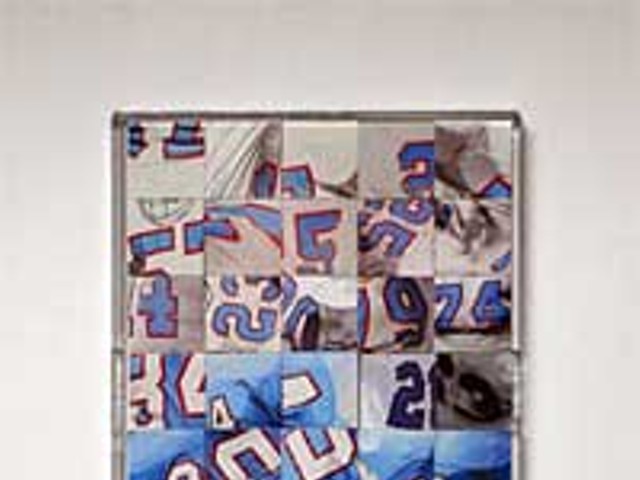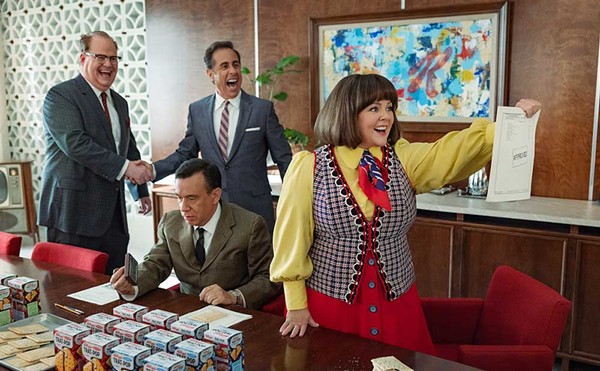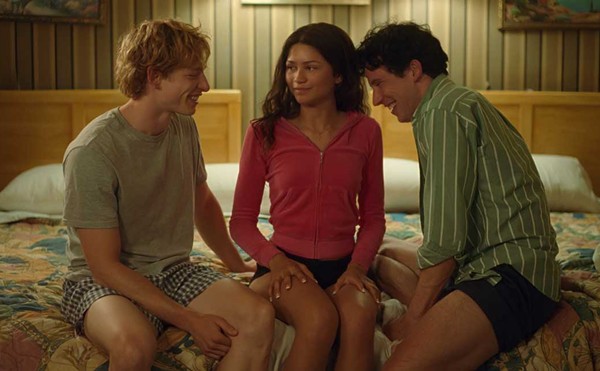Sensuous images, childhood memories and scuttling creatures come out to play in A Ship in a View, an event by the Japanese troupe Pappa Tarahumara that blends dance, music and theater into a multimedia performance.
A large pole represents a ship on a shore; its silk flag flutters in a breeze. Pools of light and rotating bulbs descend and rise. Light and darkness clash as performers, dressed in black skirts, tunics and dresses with halter tops move on stage. Sometimes, the dancers are merely silhouettes casting huge shadows. The pictures and scenes in Ship resemble memories or bad dreams.
The memories actually belong to creator-choreographer Hiroshi Koike, who grew up in Hitachi, a seaside coal-mining and fishing village in Japan. "On the shore, I saw people struggling and fighting, people of many classes conflicted," Koike says. In this piece, he incorporates those recollections elusively, saying that "strange people with problems gather at different places, such as the beach or the schoolyard." The choreographer compares the story line to one by Russian playwright Anton Chekhov: Bad things happen, but the work is both tragic and comic.
Koike says each performer — of a group of eight women and four men trained in classical and modern dance, as well as theater — plays several roles in this show, but there's nothing about A Ship in a View that's improvised. Koike's background is in martial arts and theater, so he incorporates movements that resemble fighting moves, such as arms rotating like a windmill. Movement conveys Koike's thoughts and feelings: Running leaps fold up onto the floor, and dancers' feet move flatly, heel to toe. Dancers perform rapid, creature-like movements on all fours, with arms rising to positions like semaphores. Most of the time, the performers appear to be enclosed in their own private spaces — even when moving in unison. A girl, sprawled on the floor, eats an apple, while another spills water onto her head from upended tumblers. A dancer climbs the pole and hangs from one arm like a rag doll. Elsewhere on stage some sing; others are perfectly still.
It sounds chaotic, but Koike has a careful plan: In the four parts of the performance, which are introduced by electric bars of light — ranging from a few feet long to the full width of the stage — the audience experiences a rising crisis leading to resolution. The musical score is computer-generated, mixed with a Japanese bamboo flute, sounding eerie, wry or threatening, but there are lulling sounds of water lapping at the shore too.
Ship is just one of many stage productions that Koike has created for the company Pappa Tarahumara, otherwise known as "Pappa T." He came up with the name for the group by reading The Peyote Dance, a book by Antonin Artaud about the Tarahumara Indians, an isolated tribe in northwest Mexico. Taking that name, he added the word pappa, which, in Japanese, is made of two nonsense syllables. His early vision for the group was to push boundaries of dance and theater. "I didn't want to fix an image in the audience's mind," he says.
Pappa Tarahumara is one of the offshoots of the butoh movement, which began in Japan in the 1950s and can be characterized by its severely slowed stage movement. "In 1956, my birth year, the Japanese government declared that Japan had passed the confusion of World War II," Koike says. "That's when Tatsumi Hijikata started butoh, which can be interpreted as 'a dead body waiting to get up again.'" The body is a metaphor for Japanese culture, and it's one that has been autopsied in many stage and outdoor pieces by artists looking for meaning in the war and its aftermath. Common to all these works is the Asian reference to time, which is an expression of Asian history and culture through social criticism, incorporating elements from Japanese Noh theater.
Butoh groups, such as Sankai Juko, have played in Detroit and in Ann Arbor. In one memorable performance, the modern dance duo Eiko and Koma performed a piece in the Huron River while the audience watched from the banks.
This is Pappa Tarahumara's first appearance in southeastern Michigan. With Ship, we take a journey into Koike's mind. Our senses are engaged by the performers, their movement, lights and sound. But, as Koike says, "The audience imagines their own stories."
The University Musical Society presents Pappa Tarahumara's A Ship in View, at 8 p.m. (not 9 p.m. as published earlier) Thursday, Feb. 23, at the Power Center, 121 Fletcher St., Ann Arbor; 734-764-2538. $16-$36.
Michael H. Margolin writes about theater and the performing arts for Metro Times. Send comments to [email protected]




